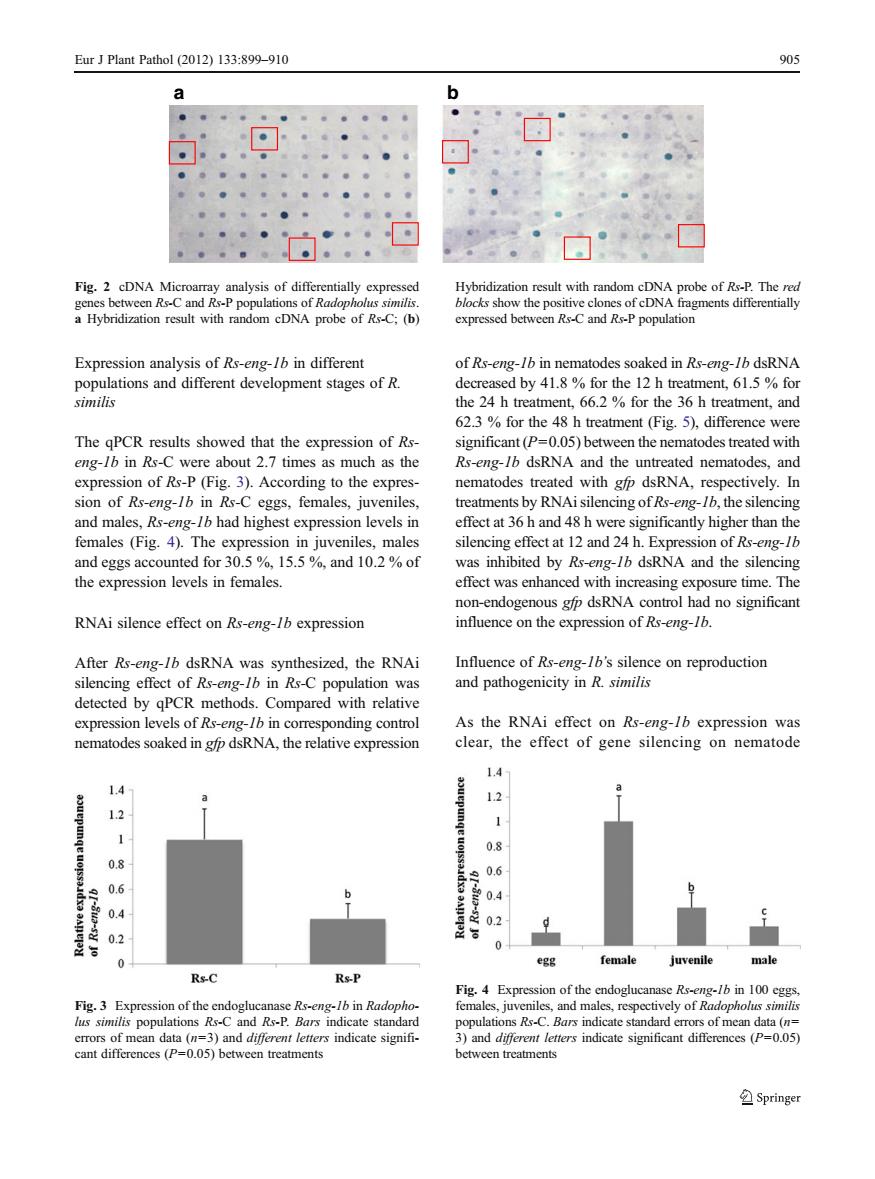正在加载图片...

Eur J Plant Pathol (2012)133:899-910 905 b 回 。。 。。。。。。 。。。。。。。。 Fig.2 cDNA Micr cnR-Cand Rs-P ve clo Expression analysis of Rs-eng-Ib in different of rs-eng-lb in nematodes soaked in rs-eng-lb dsRNA populations and different development stages of R. decreased by 41.8%for the 12 h treatment,61.5%for similis the 24 h treatment,66.2%for the 36 h treatment,and 62.3%for the 48 h treatment (Fig.5),difference were The qPCR results showed that the expression of Rs significant(P=0.05)between the nematodes treated with eng-Ib in Rs-C were about 2.7 times as much as the Rs-eng-76 dsRNA and the untreated nematodes,and expression of Rs-P(Fig.3).According to the expres- nematodes treated with gip dsRNA,respectively.In sion of Rs-eng-Ib in Rs-C eggs,females,juveniles treatments by RNAi silencing of Rs-eng-1b,the silencing and males.Rs-eng-/b had highest expression levels in effect at 36 h and 48 h were significantly higher than the females (Fig.4).The expression in juveniles,males silencing effect at 12 and 24 h.Expression of Rs-eng-/b and eggs accounted for 30.5%.15.5%.and 10.2%of was inhibited by Rs-eng-1b dsRNA and the silencing the expression levels in females. effect was enhanced with increasing exposure time.The non-endogenous gfp dsRNA control had no significant RNAi silence effect on Rs-eng-1b expression influence on the expression of Rs-eng-/6. After Rs-eng-/b dsRNA was synthesized,the RNAi Influence of Rs-eng-/b's silence on reproduction silencing effect of Rs-eng-Ib in Rs-C population was and pathogenicity in R.similis detected by qPCR methods.Compared with relative expression levels of Rs-eng-Ib in corresponding control As the RNAi effect on Rs-eng-1b expression was nematodes soaked ing dsRNA.the relative expression clear,the effect of gene silencing on nematode 1.4 12 08 06 04 02 0 Fig.3 Expression of the endoglucanase Rs-eng-lb in Radopho us similis populations Rs-C an d Rs-P.Bars indicate standar 005) cant differences(P=0.05)between treatments veen treatments Springe Expression analysis of Rs-eng-1b in different populations and different development stages of R. similis The qPCR results showed that the expression of Rseng-1b in Rs-C were about 2.7 times as much as the expression of Rs-P (Fig. 3). According to the expression of Rs-eng-1b in Rs-C eggs, females, juveniles, and males, Rs-eng-1b had highest expression levels in females (Fig. 4). The expression in juveniles, males and eggs accounted for 30.5 %, 15.5 %, and 10.2 % of the expression levels in females. RNAi silence effect on Rs-eng-1b expression After Rs-eng-1b dsRNA was synthesized, the RNAi silencing effect of Rs-eng-1b in Rs-C population was detected by qPCR methods. Compared with relative expression levels of Rs-eng-1b in corresponding control nematodes soaked in gfp dsRNA, the relative expression of Rs-eng-1b in nematodes soaked in Rs-eng-1b dsRNA decreased by 41.8 % for the 12 h treatment, 61.5 % for the 24 h treatment, 66.2 % for the 36 h treatment, and 62.3 % for the 48 h treatment (Fig. 5), difference were significant (P00.05) between the nematodes treated with Rs-eng-1b dsRNA and the untreated nematodes, and nematodes treated with gfp dsRNA, respectively. In treatments by RNAi silencing of Rs-eng-1b, the silencing effect at 36 h and 48 h were significantly higher than the silencing effect at 12 and 24 h. Expression of Rs-eng-1b was inhibited by Rs-eng-1b dsRNA and the silencing effect was enhanced with increasing exposure time. The non-endogenous gfp dsRNA control had no significant influence on the expression of Rs-eng-1b. Influence of Rs-eng-1b’s silence on reproduction and pathogenicity in R. similis As the RNAi effect on Rs-eng-1b expression was clear, the effect of gene silencing on nematode Fig. 3 Expression of the endoglucanase Rs-eng-1b in Radopholus similis populations Rs-C and Rs-P. Bars indicate standard errors of mean data (n03) and different letters indicate significant differences (P00.05) between treatments Fig. 4 Expression of the endoglucanase Rs-eng-1b in 100 eggs, females, juveniles, and males, respectively of Radopholus similis populations Rs-C. Bars indicate standard errors of mean data (n0 3) and different letters indicate significant differences (P00.05) between treatments a b Fig. 2 cDNA Microarray analysis of differentially expressed genes between Rs-C and Rs-P populations of Radopholus similis. a Hybridization result with random cDNA probe of Rs-C; (b) Hybridization result with random cDNA probe of Rs-P. The red blocks show the positive clones of cDNA fragments differentially expressed between Rs-C and Rs-P population Eur J Plant Pathol (2012) 133:899–910 905